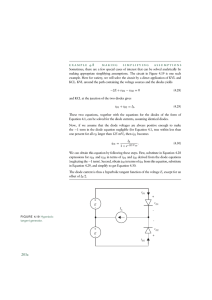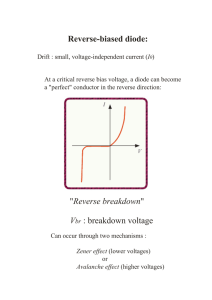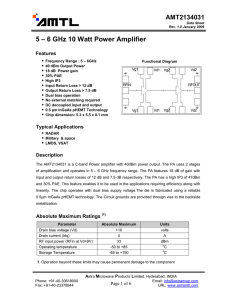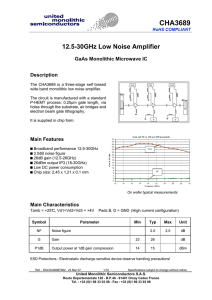Uploaded by
SITI FARHANA BAJUNID BINTI SHAKEEB ARSALAAN BAJUNID MRS211044
Transportation Model for University Efficiency
advertisement
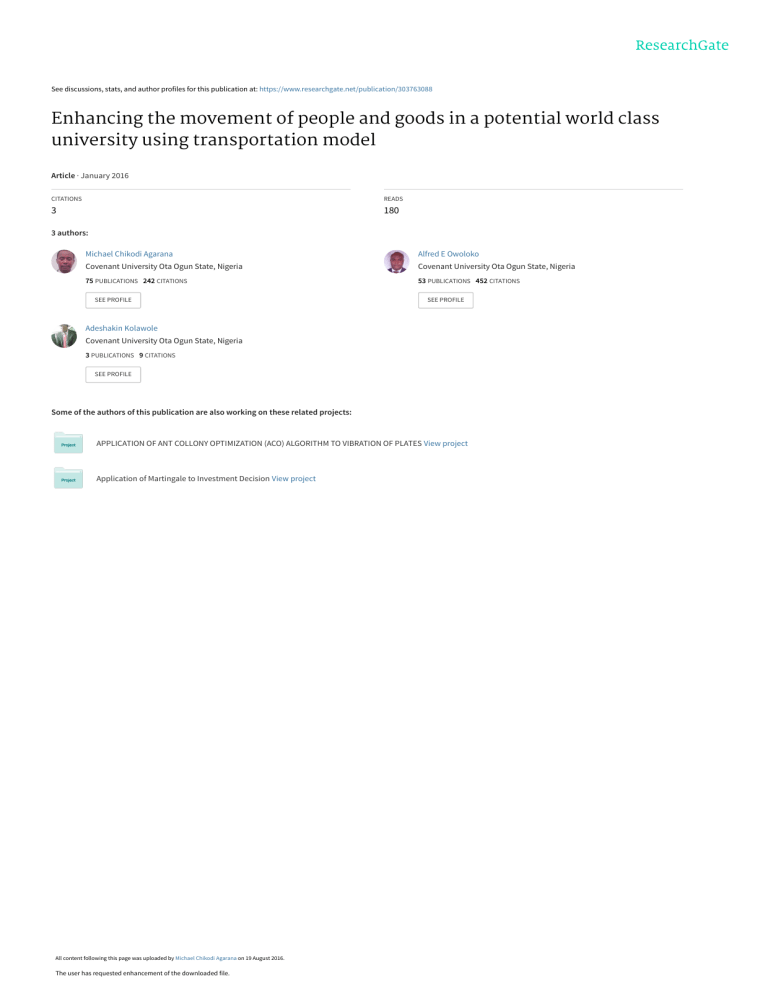
See discussions, stats, and author profiles for this publication at: https://www.researchgate.net/publication/303763088 Enhancing the movement of people and goods in a potential world class university using transportation model Article · January 2016 CITATIONS READS 3 180 3 authors: Michael Chikodi Agarana Alfred E Owoloko Covenant University Ota Ogun State, Nigeria Covenant University Ota Ogun State, Nigeria 75 PUBLICATIONS 242 CITATIONS 53 PUBLICATIONS 452 CITATIONS SEE PROFILE SEE PROFILE Adeshakin Kolawole Covenant University Ota Ogun State, Nigeria 3 PUBLICATIONS 9 CITATIONS SEE PROFILE Some of the authors of this publication are also working on these related projects: APPLICATION OF ANT COLLONY OPTIMIZATION (ACO) ALGORITHM TO VIBRATION OF PLATES View project Application of Martingale to Investment Decision View project All content following this page was uploaded by Michael Chikodi Agarana on 19 August 2016. The user has requested enhancement of the downloaded file. Global Journal of Pure and Applied Mathematics. ISSN 0973-1768 Volume 12, Number 1 (2016), pp. 281-294 © Research India Publications http://www.ripublication.com Enhancing the Movement of People and Goods in A Potential World Class University using Transportation Model 1 1 Agarana M. C., 1Owoloko E. A. and 2Kolawole A. A. Department of Mathematics, Covenant University, Nigeria. 2 Department of Computer and Information Systems, Covenant University, Nigeria. Abstract Most world class universities are like small cities because of their sizes and compositions. They therefore face urban transportation problems due to increase in human activities. This paper looks at minimizing the time spent to move from one point to another in Covenant University. Covenant University is a potential world class university whose fast growth in the past twelve years can lead to transportation problems in the future if the transportation system is not properly planned. Transportation problem is one of the major areas of application of linear programming. Google map was used to calculate the distance and time it takes to move from one point to the other in the University. Three transportation methods: Northwest corner method, least cost method and Vogel Approximation method were used to find the initial feasible solution, while MODI method was used to find the optimal solution. The optimal solution shows that the movement of people and goods can be enhanced in Covenant University if time spent to move from one point to another is reduced. Reduction in the time spent reduces stress and results in having more time to attend to more pressing issues. Keywords: Transportation model, World class university, Movement of people and goods. Introduction Transportation problem is one of the important problems of network flow, which is usually used to minimize the cost of transportation for firms, industries with number of sources and destination while satisfying the supply limit and demand requirement. It is a special type of Linear programming problem. [11] F. L. Hitchcock [1] firstly 282 Agarana M. C. Et al presented transportation problem in his paper “he Distribution of a Product from Several sources to numerous Localities” and after that, T. C. Koopmans [2] in his historic paper “Optimum Utilization of the Transportation System” made his presentation. These researchers’ contributions helped in the development of transportation methods which involve a number of shipping sources and a number of destinations. In the recent past, Transportation Problem with a different single objective to minimize the duration of transportation has been studied by many researchers such as Sharma and Swarup [3], Seshan and Tikekar [4], Prakash, Papmanthou [5], and Sonia, Sonia et al [6]. They studied on time transportation problem. Researchers such as Wahead and Lee [7] Surapati and Roy [8] and Zangibadi and Maleki [9] also presented a fuzzy goal programming approach to determine an optimal solution for the multi-objective transportation problem. All these researches were carried out to solve the transportation problem and this show us clearly that transportation problem is a problem that really needs to be solved. Solving transportation problems in a potential university therefore, would enhance its chance of becoming a full fleshed world class university, especially now that competition among the universities to be ranked as one of the best universities in the world is on the increase. Covenant University is a potential world class university located at Ota, Ogun state, Nigeria. It was recently ranked number one in the webometrics ranking of Universities. It possesses the major characteristics that distinguish the top universities from all other universities, whichare: high concentration of talented teachers, researchers and students; sizable budgets(funding), and a combination of freedom, autonomy and leadership[11]. World class Universities are like small cities, with similar amenities such as athletic facilities, event halls, housing, hospitals, libraries, museums, offices, parking spaces, restaurants, stores, theatres, and, of course, classrooms. So they are bound to also face urban transportation problems. The potential world class universities shouldplan to reduce congestion, clean the air, conserve energy, and improve campus life [10, 12, 13, 14]. In this paper we focused on how time spent to move from one point (origin) to another (destination) can be optimized in order to enhance the movement of people and goods in Covenant University campus. Problem Definition Assumptions: In this paper, the following assumptions are made: (i) There are only five origins and five destinations in Covenant university campus (ii) All the routes mentioned in this paper are always accessible. (iii) The time spent to move from one origin to a destination is always the same. (iv) Movement of People and Goods are always from those spots named origin to those spots named destinations, not the other way round. (v) The same means of transportation and constant speed Enhancing The Movement Of People And Goods 283 Transportation Tableau: For this paper we considered ten important spots on campus. Five of them as origins and the other five as destinations. Table 1 below shows names and notations of these spots, while table 2 represents the transportation tableau. Table 1: Origins and destinations considered Origin Destination O1 Main Gate D1 C. S. T O2 Hebron water D2 C. D. S O3 Camp house D3 Library O4 C. U. Gate D4 Café 1 O5 Faith tabernacle D5 Guest house Table 2: The Transportation Tableau D1 1. 5 O1 2. 0 O2 2. 5 O3 0. 8 O4 3. 4 O5 Expected Distance 17 D2 2. 1 2. 6 3. 1 1. 4 3. 4 24 D3 1. 9 2. 5 2. 9 1. 2 3. 8 23 D4 2. 7 3. 8 3. 7 2. 0 4. 6 32 D5 Actual Distance 2. 1 19 2. 6 25 3. 1 31 2. 0 14 4. 0 34 27 Each cell in the tableau represents the distance covered from one source (origin) to one destination. Thus the number placed in each cell is the value of a decision variable for that cell. The numbers presently in table 2 represent time per unit distance between one origin and one destination. Along the outer rim of the tableau are the required distance and expected distance constraint quantity values, which are referred to as rim requirements. Note that the sum of the actual distance is the same as the sum of the expected distance. Problem Solution We intend to find the route that will require the least time to cover the distance involved. So we adopt transportation model by treating cost as time. We now minimise time instead of minimizing cost. We start by obtaining the initial feasible solution via the three methods: North West Corner Method, Least Cost Method, and Vogel’s Approximation Method respectively. The least initial feasible solution is then tested for optimality using MODI method, provided certain conditions are satisfied. 284 Agarana M. C. Et al Methods of finding Initial Feasible Solutions: The three methods, among others, used to obtain the initial feasible solutions of a transportation model are the Northwest corner method, The Minimum Cell Cost Method, and the Vogel’s Approximation Model. For optimality test however, the MODI method was adopted. In the northwest corner method, an initial allocation is made to the cell in the upper left-hand, that is north-west, corner of the transportation initial tableau subject to the supply and demand constraints for that cell. Then the next cell, in the second row or second column will only be proceeded to, provided supply or demand for the first row or column has been exhausted. This procedure continues until full allocation of the total available quantity has successfully been done to the required cells. [15, 16] The second method used to obtain an initial feasible solution is the Minimum Cell Cost Method, also known as the minimum matrix method. Here, the cell containing the smallest value per unit is to be located first. In case there are more than two least costs, we use the row and column that tend to correspond with the row having the least value. But in case they seem to be in the row, then the column with the lowest value will have to be selected. We then choose the corresponding value, subject to constraints in capacity and requirement as much as possible. Satisfying supply will imply that the row be iterated so that all restrictions can be met. [15, 16] The third method is the Vogel’s Approximation Model. This method is based on the concept of penalty cost or regrets. It is about first of all determining the difference between two identified cell values and written same against the corresponding row on the side of the table. This procedure has to be repeated for columns whereby the cell with the minimum transportation cost with the next to minimum transportation cost have to be identified in each column and their difference determined so that it can be written against the corresponding column. This is followed by determining the maximum difference so that in case it is located on the side of the table, maximum allotment is granted to the cell with the minimum cost of transportation in that particular column. In the case of corresponding differences for two or more rows/columns are termed as being equal, the row on the very upper part of the table and the far left column should be selected. [15] Initial feasible solutions: The initial feasible solutions obtained using the three methods mentioned above are shown via tables 3, 4 and 5 respectively. Table 3: The initial solution obtained by using the North West Corner Method Total Time Spent = 17 x 1. 5 + 2 x 2. 1 + 22 x 2. 6 + 3 x 2. 5 + 20 x 2. 9 + 11 x 3. 7 + 14 x 2 + 7 x 4. 6 + 27 x 4 = 360. 1 O1 O2 O3 O4 O5 Expected Distance D1 1. 5 17 2. 0 2. 5 0. 8 3. 4 17 D2 2. 12 2. 622 3. 1 1. 4 3. 4 24 D3 1. 9 2. 53 2. 920 1. 2 3. 8 23 D4 2. 7 3. 8 3. 711 2. 014 4. 67 32 D5 2. 1 2. 6 3. 1 2. 0 4. 027 27 Actual distance 19 25 31 14 34 Enhancing The Movement Of People And Goods 285 Table 4: The initial solution obtained by using Least Cost Method Total = 14 × 0. 8 + 3 × 1. 5 + 16 × 1. 9 + 7 × 2. 5 + 18 × 2. 6 + 6 × 3. 1 + 25 × 3. 1 + 2 × 4 + 32 × 4. 6 = 361. 7 D1 D2 D3 D4 D5 Actual distance 1. 53 2. 1 1. 916 2. 7 2. 1 19 O1 18 7 2. 0 2. 6 2. 5 3. 8 2. 6 25 O2 6 25 2. 5 3. 1 2. 9 3. 7 3. 1 31 O3 0. 814 1. 4 1. 2 2. 0 2. 0 14 O4 32 2 3. 4 3. 4 3. 8 4. 6 4. 0 34 O5 17 24 23 32 27 Expected Distance Table 5: The initial solution obtained by using Vogel’s Approximation Method Total = 14 × 1. 4 + 19 × 2. 7 + 17 × 2. 5 + 25 × 2. 6 + 14 × 2. 9 + 13 × 4. 6 + 2 × 4 + 9 × 3. 8 + 10 × 3. 4 = 355 D1 D2 D3 D4 D5 Actual distance 19 1. 5 2. 1 1. 9 2. 7 2. 1 19 O1 2. 0 2. 6 2. 5 3. 8 2. 625 25 O2 17 14 2. 5 3. 1 2. 9 3. 7 3. 1 31 O3 14 0. 8 1. 4 1. 2 2. 0 2. 0 14 O4 3. 4 3. 410 3. 89 4. 613 4. 02 34 O5 17 24 23 32 27 Expected Distance It can be seen from tables 3, 4 and 5 that Vogel’s Approximation Method gives us the least initial feasible solution. Having determined the basic feasible solution, we now solve the model for the optimal (i. e minimum total time) solution. For this paper, in order to obtain the optimal solution we use MODI (modified distribution) method. The MODI method is one of the methods of finding the optimal solution. It is often preferred because of its time saving advantage over other methods. [17] A number of steps have to be followed. These include using one of the earlier three methods to find the initial feasible solution. Next is to determine dual variables Ui and Vj using Ui + Vj = Cij. This will then facilitate computation of the opportunity cost as Cij – Ui – Vj = Kij. In case the opportunity cost for all cells not occupied are either zero or positive, the remaining solution will be the optimal solution. But if any of the unoccupied cells has a negative opportunity cost, then the resulting solution cannot be considered as the optimal solution, therefore, the cell having the least negative opportunity cost but not occupied will be selected as the cell to be included in the solution to be computed next. A closed path for the unoccupied selected cell is then drawn, whereby positive and negative signs are assigned on the corner point of the unoccupied cells’ closed path. The path drawn helps determine the maximum number of units that can be transferred through the best unused route. [17] The positive sign is usually placed on the cell under evaluation. From here, the maximum number of units to be transported to the unoccupied cell being evaluated has to be determined. Thereby the smallest 286 Agarana M. C. Et al value having value having a minus position on the closed loop will represent the units to be transported to the entering cell. This is the quantity that will have to be added to all cells located on the corner points of the closed loop containing a positive signs and be subtracted from negative cells, hence turning an unoccupied cell into being occupied. This procedure will have to be repeated severally until an optimum solution is obtained. [15] Now, because the initial solution obtained by the Vogel’s approximation method, above, has the lowest total time of the three initial solutions, we used it as the starting solution. Conditions for acceptability before Optimality Test: For this problem, the number of occupied cell = m+n-1 = 5+5-1= 9, which is equal to the number of occupied cells, and the allocations are independent positions. So we proceed to the optimality test. Optimality Test: In order to check if the feasible solution given by the Vogel’s Approximation method is actually the optimal solution, we carry out an optimality test using the MODI method. To demonstrate MODI, we start by carrying out some modifications on table 5 to obtain table 6. Table 6: The Vogel’s approximation initial solution with Ui left-hand column and Vj top row Vj VD1 = VD2 = VD3 = VD4 = VD5= Ui D1 D2 D3 D4 D5 Actual distance U1 = O1 1. 5 2. 1 1. 9 2. 719 2. 1 19 U2 = O2 2. 0 2. 6 2. 5 3. 8 2. 6 25 25 U3 = O3 2. 517 3. 1 2. 914 3. 7 3. 1 31 U4 = O4 0. 8 1. 4 14 1. 2 2. 0 2. 0 14 U5 = O5 3. 4 3. 410 3. 89 4. 6 13 4. 02 34 17 24 23 32 27 143 Expected Distance The extra left-hand column with the Ui symbols and the extra top row with the Vj symbols represent column and row values that must be computed in MODI. The cells with allocations are used to compute the values of Ui and Vj with the following formular: Ui + Vj = Cij (1) Cij is one unit of time spent for cell ij U1 + VD4 = C1D4 (2) for cell X1D4: U1 + VD4 = 2. 7 (3) The formular for other cells that presently contain allocations are X2D5: U2+ VD5 = 2. 1 (4) X3D1: U3 + VD1 = 2. 5 (5) Enhancing The Movement Of People And Goods 287 X3D3: U3 + VD3 = 2. 9 (6) X4D2: U4 + VD2 = 1. 4 (7) X5D2: U5 + VD2 = 3. 4 (8) X5D3: U5 + VD3 = 3. 8 (9) X5D4: U5 + VD4 = 4. 6 (10) X5D5: U5 + VD5 = 4. 0 (11) Now there are nine equations with ten unknowns. To solve these equations, it is necessary to assign only one of the unknowns a value of zero. Thus if we let U1 = 0, we can solve for all remaining Ui and Vj values. From equation (3), we have 0 + VD4 = 2. 7 (12) VD4 = 2. 7 (13) Substituting equation (13) into equation (10) gives U5 = 1. 9 (14) Substituting equation (14) into equation (11) gives VD5 = 2. 1 (15) Substituting equation (15) into equation (4) gives U2 = 0. 0 (16) Substituting equation (14) into equation (9) gives VD3 = 1. 9 (17) Substituting equation (17) into equation (6) gives U3 = 1. 0 (18) Substituting equation (18) into equation (5) gives VD1 = 1. 5 (19) Substituting equation (14) into equation (8) gives VD2 = 1. 5 (20) Substituting equation (20) into equation (7) gives U4 =-0. 1 (21) Now we can substitute all the values of Ui and Vj into the tableau as shown in table7 Table 7: The initial solution with all Ui and Vj values Vj VD1 = 1. 5 VD2 = 1. 5 VD3 = 1. 9 VD4 = 2. 7 VD5 = 2. 1 D1 D2 D3 D4 D5 Actual distance U1 = 0. 0 O1 1. 5 2. 1 1. 9 2. 7 19 2. 1 25 19 U2 = 0. 0 O2 2. 0 2. 6 2. 5 3. 8 2. 6 25 U3 = 1. 0 O3 2. 5 17 3. 1 2. 9 14 3. 7 3. 1 31 U4 =-0. 1 O4 0. 8 1. 4 14 1. 2 2. 0 2. 0 14 U5 = 1. 9 O5 3. 4 3. 4 10 3. 8 9 4. 6 13 4. 0 2 34 17 24 23 32 27 143 Expected Distance Ui 288 Agarana M. C. Et al The basic solution principle in a transportation problem is to determine whether a transportation route not at present being used (i. e. an empty cell) would result in a lower total time if it were used. So, we use the following formula to evaluate all empty cells: Cij – Ui – Vj = Kij (22) Where Kij equals the time increase or decrease that would occur by allocating to a cell. For the empty cells in table 7, equation (22) yields the following values: X1D1: K1D1 = C1D1 – U1 – VD1 = 1. 5 – 0. 0 – 1. 5 = 0. 0 (23) X2D1: K2D1 = C2D1 – U2 – VD1 = 2. 0 – 0. 0 – 1. 5 = 0. 5 (24) X4D1: K4D1 = C4D1 – U4 – VD1 = 0. 8 – – 0. 1-1. 5 =-0. 6 (25) X5D1: K5D1 = C5D1 – U5 – VD1 = 3. 4 – 1. 9 – 1. 5 = 0. 0 (26) X1D2: K1D2 = C1D2 – U1 – VD2 = 2. 1 – 0. 0 – 1. 5 = 0. 6 (27) X2D2: K2D2 = C2D2 – U2 – VD2 = 2. 6 – 0. 0 – 1. 5 = 1. 1 (28) X3D2: K3D2 = C3D2 – U3 – VD2 = 3. 1 – 1. 0 – 1. 5 = 0. 6 (29) X1D3: K1D3 = C1D3 – U1 – VD3 = 1. 9 – 0. 0 – 1. 9 = 0. 0 (30) X2D3: K2D3 = C2D3 – U2 – VD3 = 2. 5 – 0. 0 – 1. 9 = 0. 6 (31) X4D3: K4D3 = C4D3 – U4 – VD3 = 1. 2 – –0. 1-1. 9 =-0. 6 (32) X2D4: K2D4 = C2D4 – U2 – VD4 = 3. 8 – 0. 0 – 2. 7 = 1. 1 (33) X3D4:K3D4 = C3D4 – U3 – VD4 = 3. 7 – 1. 0 – 2. 7 = 0. 0 (34) X4D4:K4D4 = C4D4 – U4 – VD4 = 2. 0 –-0. 1 – 2. 7 =-0. 6 (35) X2D5: K2D5 = C2D5 – U2 – VD5 = 2. 6 – 0. 0 – 2. 1 = 0. 5 (36) X3D5: K3D5 = C3D5 – U3 – VD5 = 3. 1 – 1. 0 – 2. 1= 0. 0 (37) X4D5: K4D5 = C4D5 – U4 – VD5 = 2. 0 –-0. 1 – 2. 1 = 0. 0 (38) These calculations indicate that either cell 4D1, cell 4D3 or cell 4D4 will decrease time by 0. 6, 0. 6, 0. 6, respectively per allocated distance. We can therefore select any of cell 4D1, cell 4D3 or cell 4D4 to allocate to, because they are tied at-0. 6. If cell 4D3 is selected as the entering non-basic variable, then using an appropriate path for the cell we allocate as follows (see table 8). Table 8: The second iteration of the MODI solution method Vj Ui U1 = U2 = U3 = U4 = U5 = VD1 = VD2 = D1 D2 VD3 = D3 VD4 = D4 VD5 = D5 O1 1. 5 2. 1 1. 9 2. 7 19 2. 1 O2 2. 0 2. 6 2. 5 3. 8 2. 6 25 O3 2. 5 17 3. 1 2. 9 14 3. 7 3. 1 O4 0. 8 1. 4 5 1. 2 9 2. 0 2. 0 O5 3. 4 3. 4 19 3. 8 4. 6 13 4. 0 2 17 24 23 32 27 Expected Distance Actual distance 19 25 31 14 34 143 Enhancing The Movement Of People And Goods 289 The Ui and Vj values for table 8 must now be recomposed using above formula in equation (1) X3D1: U3+ VD1 = 2. 5 1. 6+ VD1 = 2. 5 VD1 =0. 9 (39) X3D3: U3+ VD3 = 2. 9 U3 + 1. 3 = 2. 9 U3 = 1. 6 (40) X1D4: U1 + VD4 = 2. 7 0 + VD4 = 2. 7 VD4 = 2. 7 (41) X2D5: U2+ VD5 = 2. 6 U2 + 2. 1 = 2. 6 U2 = 0. 5 (42) X4D2: U4 + VD2 = 1. 4 U4 + 1. 5 = 1. 4 U4=-0. 1 (43) X4D3: U4 + VD3 = 1. 2 -0. 1 + VD3 = 1. 2 VD3 = 1. 3 (44) X5D2: U5 + VD2 = 3. 4 1. 9 + VD2 = 3. 4 VD2 = 1. 5 (45) X5D4: U5 + VD4 = 4. 6 U5 + 2. 7 = 4. 6 U5= 1. 9 (46) X5D5: U5 + VD5 = 4. 0 1. 9+ VD5 = 4. 0 VD5 = 2. 1 (47) Table 9: The new Ui and Vj values for the second iteration Vj VD1 = 0. 9 VD2 = 1. 5 VD3 = 1. 3 VD4 = 2. 7 VD5 = 2. 1 D1 D2 D3 D4 D5 Actual distance U1 = 0. 0 O1 1. 5 2. 1 1. 9 2. 7 19 2. 1 19 U2 = 0. 5 O2 2. 0 2. 6 2. 5 3. 8 2. 6 25 25 U3 = 1. 6 O3 2. 5 17 3. 1 2. 9 14 3. 7 3. 1 31 U4 =-0. 1 O4 0. 8 1. 4 5 1. 2 9 2. 0 2. 0 14 U5 = 1. 9 O5 3. 4 3. 4 19 3. 8 4. 6 13 4. 0 2 34 17 24 23 32 27 143 Expected Distance Ui 290 Agarana M. C. Et al The time change for the empty cells are now computed using the formula in equation (22): X1D1: K1D1 = C1D1 – U1 – VD1= 1. 5 – 0. 0 – 1. 4 = 0. 1 (48) X2D1: K2D1 = C2D1 – U2 – VD1 = 2. 0 – 0. 0 – 1. 5 = 0. 6 (49) X4D1: K4D1 = C4D1 – U4 – VD1 = 0. 8 – – 0. 1 – 0. 9 = 0. 0 (50) X5D1: K5D1 = C5D1 – U5 – VD1 = 3. 4 – 1. 9 – 1. 5 = 0. 0 (51) X1D2: K1D2 = C1D2 – U1 – VD2 = 2. 1 – 0. 0 – 1. 5 = 0. 6 (52) X2D2: K2D2 = C2D2 – U2 – VD2 = 2. 6 – 0. 5 – 1. 5 = 0. 6 (53) X3D2: K3D2 = C3D2 – U3 – VD2 = 3. 1– 1. 6 – 1. 5 = 0. 0 (54) X1D3: K1D3 = C1D3 – U1 – VD3 = 1. 9 – 0. 0 – 1. 9 = 0. 0 (55) X2D3: K2D3 = C2D3 – U2 – VD3 = 2. 5 – 0. 5 – 1. 3 = 1. 7 (56) X4D3: K4D3 = C4D3 – U4 – VD3 = 1. 2 – –0. 1-1. 3 = 0. 0 (57) X2D4: K2D4 = C2D4 – U2 – VD4 = 3. 8 – 0. 0 – 2. 7 = 1. 1 (58) X3D4: K3D4 = C3D4 – U3 – VD4 = 3. 7 – 1. 0 – 2. 7 = 0. 0 (59) X4D4: K4D4 = C4D4 – U4 – VD4 = 2. 0 –-0. 1 – 2. 7 =-0. 6 (60) X1D5: K1D5 = C1D5 – U1 – VD5 = 2. 1 – 0. 0 – 2. 1 = 0. 0 (61) X3D5: K3D5 = C3D5 – U3 – VD5 = 3. 1 – 1. 0 – 2. 1= 0. 0 (62) X4D5: K4D5 = C4D5 – U4 – VD5 = 2. 0 –-0. 1 – 2. 1 = 0. 0 (63) Once again these calculations indicate that cell 4D4 will decrease time by 0. 6 per allocated distance. We can therefore allocate to cell 4D4. If cell 4D4 is now the entering non-basic variable, then using an appropriate path for the cell we allocate as follows (see table 10). Table 10: The third iteration of the MODI solution method Vj Ui U1 = U2 = U3 = U4 = U5 = VD1 = VD2 = D1 D2 VD3 = D3 VD4 = D4 VD5 = D5 O1 1. 5 2. 1 1. 9 2. 7 19 2. 1 O2 2. 0 2. 6 2. 5 3. 8 2. 6 25 O3 2. 5 17 3. 1 2. 9 14 3. 7 3. 1 O4 0. 8 1. 4 1. 2 9 2. 0 5 2. 0 O5 3. 4 3. 4 24 3. 8 4. 6 8 4. 0 2 17 24 23 32 27 Expected Distance Actual distance 19 25 31 14 34 143 The Ui and Vj values for table 8 must now be recomposed using above formula in equation (1) X3D1: U3 + VD1 = 2. 5 1+ VD1 = 2. 5 VD1 = 1. 5 (64) X5D2: U5 + VD2 = 3. 4 1. 9 + VD2 = 3. 4 Enhancing The Movement Of People And Goods VD2 = 1. 5 X3D3: U3 + VD3 = 2. 9 U3 + 1. 9 = 2. 9 U3 = 1. 0 X4D3: U4 + VD3 = 1. 2 -0. 7+ VD3 = 1. 2 VD3 = 1. 9 X1D4: U1+ VD4 = 2. 7 0 + VD4 = 2. 7 VD4 = 2. 7 X4D4: U4 + VD4 = 2. 0 U4 + 2. 7 = 2. 0 U4 =-0. 7 X5D4: U5 + VD4 = 4. 6 U5 + 2. 7 = 4. 6 U5 = 1. 9 X2D5: U2 + VD5 = 2. 6 U2 + 2. 1 = 2. 6 U2 = 0. 5 X5D5: U5+ VD5 = 4. 0 1. 9 + VD5 = 4. 0 VD5 = 2. 1 291 (65) (66) (67) (68) (69) (70) (71) (72) Table 11: The new Ui and Vj values for the third iteration Vj VD1 = 1. 5 VD2 = 1. 5 VD3 = 1. 9 VD4 = 2. 7 VD5 = 2. 1 Ui D1 D2 D3 D4 D5 Actual distance U1 = 0. 0 O1 1. 5 2. 1 1. 9 2. 7 19 2. 1 19 U2 = 0. 5 O2 2. 0 2. 6 2. 5 3. 8 2. 6 25 25 U3 = 1. 0 O3 2. 5 17 3. 1 2. 9 14 3. 7 3. 1 31 U4 =-0. 7 O4 0. 8 1. 4 1. 2 9 2. 0 5 2. 0 14 U5 = 1. 9 O5 3. 4 3. 4 24 3. 8 4. 6 8 4. 0 2 34 17 24 23 32 27 143 Expected Distance Again, the time change for the empty cells are now computed using the formula in equation (22): X1D1: K1D1 = C1D1 – U1 – VD1 = 1. 5 – 0. 0 – 1. 5 = 0. 0 (73) X2D1: K2D1 = C2D1 – U2 – VD1 = 2. 0 – 0. 5 – 1. 5 = 0. 0 (74) X4D1: K4D1 = C4D1 – U4 – VD1 = 0. 8 – – 0. 7 – 1. 5 = 0. 0 (75) X5D1: K5D1 = C5D1 – U5 – VD1 = 3. 4– 1. 9 – 1. 5 = 0. 0 (76) X1D2: K1D2 = C1D2 – U1 – VD2 = 2. 1 – 0. 0 – 1. 5 = 0. 6 (77) X2D2: K2D2 = C2D2 – U2 – VD2 = 2. 6 – 0. 5 – 1. 5 = 0. 6 (78) X3D2: K3D2 = C3D2 – U3 – VD2 = 3. 1 – 1– 1. 5 = 0. 6 (79) 292 Agarana M. C. Et al X4D2: K4D2 = C4D2 – U4 – VD2 = 1. 4 –-0. 7 – 1. 5 = 0. 6 X3D4: K3D4 = C3D4 – U3 – VD4 = 3. 7– 1. 0 – 2. 7 = 0. 0 X1D3: K1D3 = C1D3 – U1 – VD3 = 1. 9 – 0. 0 – 1. 9 = 0. 0 X2D3: K2D3 = C2D3 – U2 – VD3 = 2. 5 – 0. 5-1. 9 = 0. 1 X5D3: K5D3 = C5D3 – U5 – VD3 = 3. 8 – 1. 9 – 1. 9 = 0. 0 X2D4: K2D4 = C2D4 – U2 – VD4 = 3. 8 – 0. 5 – 2. 7 = 0. 6 X3D4: K3D4 = C3D4 – U3 – VD4 = 3. 7 – 1. 0 – 2. 7 = 0. 0 X1D5: K1D5 = C1D5 – U1 – VD5 = 2. 1 – 0. 0 – 2. 1 = 0. 0 X3D5: K3D5 = C3D5 – U3 – VD5 = 3. 1 – 1. 0 – 2. 1= 0. 0 X4D5: K4D5 = C4D5 – U4 – VD5 = 2. 0 –-0. 7 – 2. 1 = 0. 6 (80) (81) (82) (83) (84) (85) (86) (87) (88) (89) Because none of these values is negative the solution shown in table 11 is optimal. However all the cells with a zero time change indicate multiple optimal solutions. The total optimal time spent, therefore, is 17x2. 5 + 24x3. 4 + 14x2. 9 + 9x1. 2 + 5x2. 0 + 8x4. 6 + 25x2. 6 + 2x4. 0 = 295. 3 Result Discussion From the above analysis, it can be seen that the initial feasible solution obtained from using the Vogel’s approximation method is the best among the three methods used to find the initial feasible solution. Testing for optimality shows that this initial feasible solution is not the optimal, because we obtained a better result via MODI method. The optimal solution in table 11 shows that as low as 295. 3 minutes can be spent to move from the origins to the destinations specified above, as against 355 minutes best initial feasible solution. The table shows that the time spent would be minimised if 17km is covered using route O3 – D1, 24km covered using route O5 – D2, 14km covered using route O3 –D3, 9km covered using route O4 – D3, 19km covered using route O1 – D4, 5km covered using route O4 – D4, 8km covered using route O5 – D4, 25km covered using route O2 – D5, 2km covered using route O5 – D5. Specifically, from table 11, route O2 – D5 should be more utilized if total time spent is to be minimized. Similarly route O5 – D5should be less utilized in order to achieve the optimal total time spent to move around the campus. Therefore in order to enhance the movement of people and goods under the assumption considered, more movement should done through route O2 – D5 than through route O5 – D5. The reasons for this may include the fact that the traffic along route O2 – D5 is very light, and the road is smooth with few or no pot holes. On the other hand, moving from faith tabernacle (O5) to the Guest house (D5) can be very tedious especially on church service days because of slow vehicular movement. Finally, the speed, which is measured as the ratio of distance to time, is as high as 9. 62 units along route O2 – D5, compared to 0. 5 units along route O5 – D5. This is as a result of the traffic situation and the nature of road along these routes. Conclusion Interest is on enhancing the movement of people and goods in Covenant University campus by optimizing the time spent to move around the campus. Covenant Enhancing The Movement Of People And Goods 293 University is a potential world class University. We looked at cost of transportation as time spent not money spent. The analysis is carried out using Northwest corner method, Least cost method, Vogel’s approximation method, and MODI method. The peculiar situation is modelled as a transportation problem. Three iterations are involved. The third iteration shows that the optimal solution is reached. This is represented in table 11. It is shows that the optimal time spent to move around the campus, under the assumptions considered in this paper, is 295. 3 minutes. We notice that the time is better than the time suggested by the ‘best’ initial feasible solution obtained using the Vogel’s approximation method. Using this optimal result obtained, will enhance the movement of people and goods in Covenant University as less time would be spent to move from the origins to the destinations. These results match with the expectation of the University as the University is driving towards becoming one of the world class universities. Suggestion for further work: This paper can be extended by carrying out a sensitivity analysis to ascertain the sensitivity of the parameters involved in the computation. This will add to the credibility of the results obtained. Also, the modified MODI method can be used for this work. References [1] [2] [3] [4] [5] [6] [7] [8] Hitchcock, F. L. “The distribution of product from several source to numerous localities”, J. Maths. Phy., vol 20, (1941), pp 224-230 Koopman, T. C. “Optimum utilization of transportation system”, Proc. Intern. Statics. Conf. Washington D. C., (1947) Sharma, J. K., Swarup, K. "Time minimizing transportation problem", Proceedings of Indian Academy of Sciences-Mathematical Sciences, Vol. 86, (1977), pp513-518 Seshan, C. R., Tikekar, V. G. “ On the Sharma Swaup algorithm for time minimizing transportation problems”, Proceeding of Indian Academy of Sciences Mathematical Science, Vol. 89, (1980), pp 101-102 Papamanthou, C., Paparrizos, K., Samaras N. "Computational experience with exterior point algorithms for the transportation problem", Applied Mathematics and Computation, Vol. 158, (2004), pp459-475 Sonia, Puri, M. C. "Two level hierarchical time minimizing transportation problem", Top, Vol. 12, No. 2, (2004), pp301-330 Wahead, W. F. and Lee, S. M. “Interactive fuzzy goal programming problem for multi-objective transportation problem”, Omega, Vol. 34, (2006) pp 158166 Surapati, P. and Roy, T. K. “Multi-objective transportation model with fuzzy parameters: Priority based fuzzy goal programming approach”, Journal of 294 [9] [10] [11] [12] [13] [14] [15] [16] [17] View publication stats Agarana M. C. Et al Transportation Systems Engineering and Information Technology, Vol. 8, (2008) pp 40-48 Zangibadi, M and Maleki, H. R. “Fuzzy goal programming for multi-objective transportation problem”, Applied Mathematics and Computation, Vol. 24, (2007), pp 449-460. Donard Shoup, Parking on a smart Campus: Lesson for Universities and Cities, Department of Urban Planning, UCIA School of Public Affairs. Agarana M. C and Olokunde T. O., Optimization of Healthcare pathways in Covenant University Health Centre, Vol 91, no 3, (2015), Pp 215-228 Brown, Jeffrey, Daniel Hess, and Donald Shoup, Fare – Free Public Transit at Universities: An Evaluation. Journal of Planning Education and Research, 2003, Vol. 23, No. 1, Fall, Pp. 69-82. Musaad AI-Mosaind, Traffic Conditions in emerging University Campus: King Saud University, Riyadh, Saudi Arabia, 2014, Vol. 7, No. 6, Pp 204 Robert B Mitchell, Transportation Problems and their Solutions, Symposium on Metropolitan Planning, 1962, Vol. 106, No. 3. Mrs. Rekha Vivek Joshi, Optimization Techniques for Transportation Problems of Three Variables, IOSR Journal of Mathematics (IOSR-JM), 2013, Vol. 9, Issue 1, Pp. 46-50. Lesson 15: Methods of finding initial solution for a transportation problem. Business management courses. org/lesson15MethodsOfFindinginitialSolution ForATransportationProblem. pdf Online Tutorial4: The MODI and VAM methods of solving transportation problems. wps. prenhall. com/wps/media/objects/9434/9660836/online_tutori als/heizer10e_tut4. pdf


